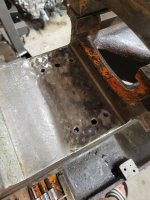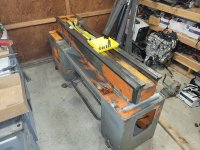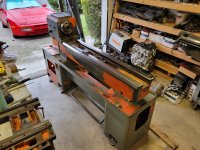arsenix
Aluminum
- Joined
- Jul 28, 2011
- Location
- Milpitas, CA
I've posted about this lathe before (https://www.practicalmachinist.com/forum/threads/way-grinding-shop-close-to-bay-area-ca.404912/ and https://www.practicalmachinist.com/forum/threads/reconditioning-my-takisawa-tsl1000.399350/ ). After giving up on finding a local grinding shop I'm going to be driving the bed down to LA in a few weeks to have the bed reground. So I'm planning my campaign to finish and put it back together. For reasons that are unclear, this lathe had the most wear on the hardened bed and the base of the saddle. I believe someone fooled with the saddle, or maybe replaced it with one from another lathe. In any case, after grinding the bed it should be dead flat. I have torn the lathe completely down and cleaned everything for inspection.
I was hoping folks could give some feedback on this plan.
Q: What is the easiest order of operations to check/refit the cross slide dovetails? It is clear to me how to get them flat (starting with the surface plate on the base of the cross slide), but I’m not sure the easiest angle.
Would love some feedback on this. As always I suspect there may be some circular work here, but I'm hoping to have a linear plan of attack that hopefully won't fall completely apart once I start!
James
I was hoping folks could give some feedback on this plan.
- Disassemble, clean up and blueprint lathe (what I’ve done so far)
- Bed wear carefully measured - wear up to .005” on hardened ways, unevenly on the V’s
- The tailstock flat way appears to be ~.006” lower than the saddle flat ways. This seems odd. Maybe a prior repair? I have checked in multiple places and it seems consistent. Given that these don’t appear to be parallel I’m not sure what to use as a leveling reference. Once the bed is ground I suppose I could level with a precision shim on the tail stock way. Due to wear on the base of the saddle I'm not sure what to use as a leveling reference. The saddle cross slide way is about .02" off from level relative to the ways.
- Apron gearbox/bearings/seals cleaned and rebuilt. Examined/cleaned up gearbox.
- Remove burrs off all machined reference surfaces and way edges.
- Check wear on cross way on saddle - .001-.002”. The ways are frosted and the frosting is just worn smooth in some areas.
- Need to check dovetail wear
- Check wear on cross way on base of cross slide - Seems minimal but will check on surface plate to double check.
- Check wear on the compound ways - both ways of the compound seem to be minimally worn. Moves smoothly with no binding.
- Bed wear carefully measured - wear up to .005” on hardened ways, unevenly on the V’s
- Grind bed
- Remove bed, headstock.
- Send bed out for way grinding.
- Power wash base and bed
- Check/fit the compound/cross slide
- Verify flatness and parallelism of the compound base on surface plate. Check wear pattern. Scrape if necessary. I currently believe these ways are pretty much perfect though.
- Check gib and scrape a bit to refit if needed.
- Verify flatness and parallelism of the cross slide base relative to the compound rotation base.
- Scrape this flat if needed until flat and parallel. Q: Given that total wear on both sides is likely only around .005” max, can I get away without turcite? Can the lead screw nuts can take this amount of misalignment?
- Realign bed and headstock
- Precisely level base
- Reinstall bed.
- Measure material removed compared to blueprint (shop should tell me, but I will double check).
- Check level on bed once reinstalled. If properly ground, should be dead level. Check for twist. Twist can be adjusted if necessary.
- Install headstock. Should have maintained perfect vertical parallelism. On this lathe it sits on scraped flat surfaces so it should maintain parallelism to the ways. It is on a pin at the front, and then has screws to shift the rear and align it.
- Adjust headstock alignment with bed. Q: Should this wait until I have the saddle running smoothly and trued again to use as an alignment guide? Should I wait until the rest of the lathe is back together and dial it in with test cuts?
- Rebuild/refit saddle
- Check wear references and level on new ground way surface.
- Verify height of saddle relative to lead screws. Unknown how much material was worn off it previously.
- Setup on mill to machine the top cross slide ways. Level as best as possible relative to original slide ways and try to get close to the original level. How much material is currently missing? These have about .001-.002 of wear on them. Q: Should I bother machining them or just try to scrape them using the cross slide as a reference? I have a fairly high precision VMC and will use a good carbide dovetail end mill. Is there a chance I can just use this surface as is post-machining?
- Machine top cross slide dovetails.
- Check level/flatness of top slideways with the counter slide. Scrape to correct for any issues.
- Setup on mill to machine bases.
- Machine flat and V ways, shooting for about X gap relative to desired height for turcite. Will shoot for some available turcite thickness. Q: How much additional should be left for scraping tolerance? Should I assume I need to machine the turcite or just go right to scraping? I could also use pour able moglice after carefully shimming which would allow for a more precise setup?
- Bond turcite onto the saddle base.
- Scrape to align/fit turcite to the saddle, verifying that the cross slide is level to the bed and perpendicular to the headstock. Q: What is the easiest way to check perpendicularity?
- Refit Slides
- Install cross slide, verify perpendicularity relative to the headstock. Deburr and reinstall the gib. Verify smooth movement.
- Reassemble the compound, deburr and reinstall the gib. Verify smooth movement.
- Recheck headstock alignment.
- Go back to step X when I find the mistakes I made.
- Reinstall everything else.
- Apron, gearbox, lead screw.
- Test cuts.
- Paint and move into final resting place.
- Bask in glory. Maybe use it to finish a project rather than being a project.
- Begin designing a large enough mausoleum so that I can be buried with this lathe.
Q: What is the easiest order of operations to check/refit the cross slide dovetails? It is clear to me how to get them flat (starting with the surface plate on the base of the cross slide), but I’m not sure the easiest angle.
Would love some feedback on this. As always I suspect there may be some circular work here, but I'm hoping to have a linear plan of attack that hopefully won't fall completely apart once I start!
James



 Once the bed is ground and I get the saddle refit it is conceivable I might not want to touch much else. My usage is pretty light so once dialed in it should stay there.
Once the bed is ground and I get the saddle refit it is conceivable I might not want to touch much else. My usage is pretty light so once dialed in it should stay there.


